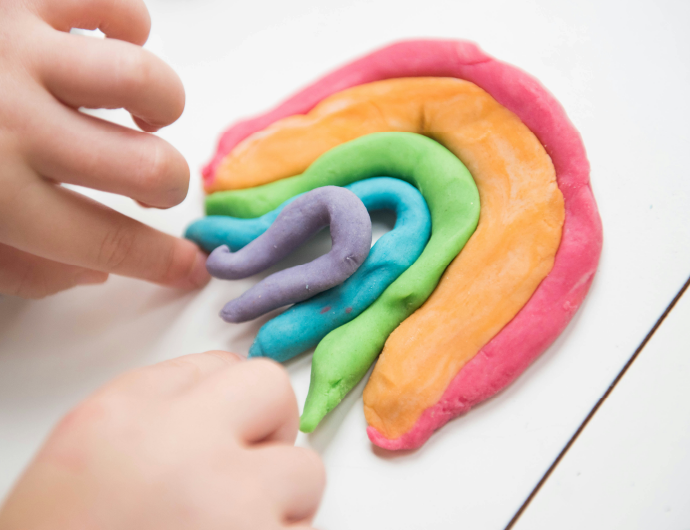BACK

Preschoolers learn best through play, exploration, and hands-on experiences. Simple activities—like mixing colours, making music, or planting seeds—build essential skills and fuel curiosity.
Experiencing the great outdoors through simple activities like playing in a neighbourhood playground or having storytime outside can enhance children’s connection with nature. For Singaporean parents, turning everyday spaces into learning zones can be easy and fun.
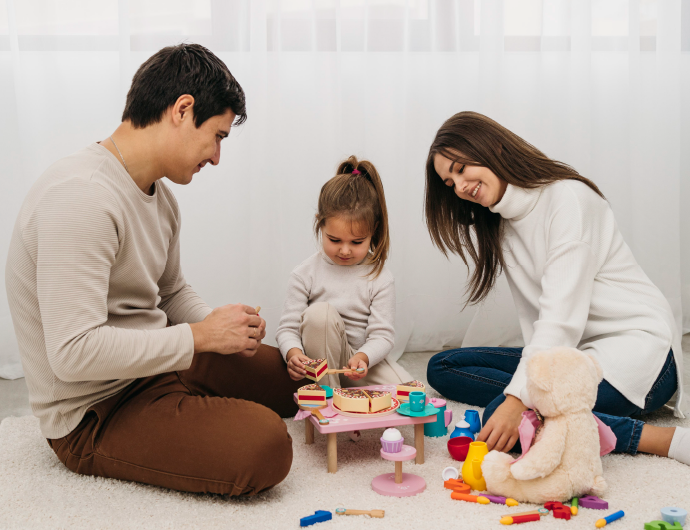
At Little Skool House, our educators believe that every environment holds the potential to inspire learning. Drawing from this philosophy, we’ve curated a series of thoughtful activity ideas—across science, music, art, movement, and language—that you can incorporate at home to support your child’s holistic development.
Science Activities for Curious Little Minds
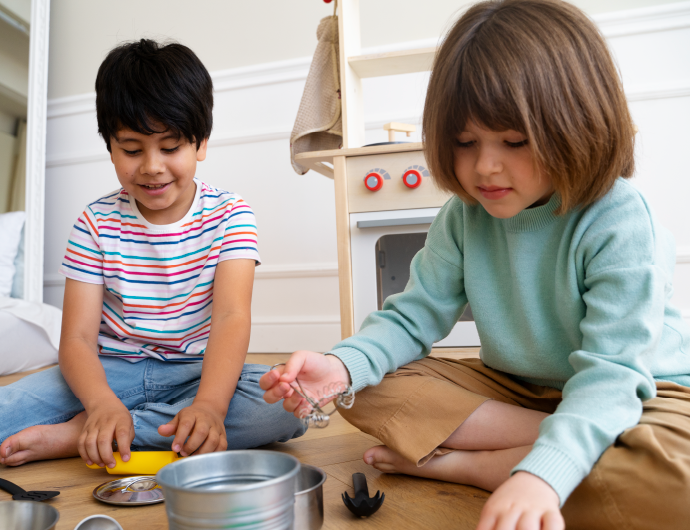
Preschool science doesn’t need fancy equipment—it’s all about encouraging your child to ask questions, observe, and explore cause and effect. These hands-on activities help children learn by supporting developmental skills such as number recognition, colour identification, and creativity.
1. Sink or Float?
Age: 3–6 years
Turn your child into a mini scientist with this simple yet thrilling water experiment. Gather everyday items like a spoon, sponge, or toy dinosaur, and challenge them to guess what will sink or float. Then, drop them in and see what happens! It’s like magic—with a dose of science.
How-To:
- Fill a clear container with water.
- Gather household items like a spoon, sponge, crayon, and various toys.
- Ask your child to guess: Will it sink or float?
- Drop each item in and observe the result together, providing an immersive sensory experience with the different textures and behaviours of the items in water.
Learning focus: Prediction, observation, density
2. Mini Volcano Eruption
Age: 3–6 years (with adult supervision)
Boom! Watch a bubbly, colourful eruption unfold right before your eyes. This fizzy volcano activity turns a regular afternoon into an unforgettable science show—perfect for sensory fun and sparking excitement about chemical reactions.
How-To:
- Add 2–3 tablespoons of baking soda into a small container.
- Mix in a few drops of food colouring and a squirt of dish soap.
- Pour vinegar into the container and watch the eruption.
Learning focus: Chemical reactions, sensory engagement
3. Bean in a Bag
Age: 4–6 years
Your child can become a little botanist with this window-side experiment. Using just a bean, a ziplock bag, and some cotton, they’ll witness the wonder of nature as roots and shoots magically appear day by day.
How-To:
- Place a bean on a damp cotton pad inside a clear ziplock bag.
- Seal the bag and tape it to a sunny window.
- Check the bag daily to observe root and sprout growth.
Learning focus: Plant life cycle, observation skills
4. Magnet Hunt
Age: 3–6 years
Send your child on a magnetic adventure! Armed with a child-safe magnet, they’ll explore your home searching for hidden “treasures” that stick—metal keys, paperclips, and more. It’s like detective work, but science-style.
How-To:
- Give your child a child-safe magnet.
- Let them explore the house, testing objects like paperclips, coins, and wooden blocks.
- Sort items into magnetic and non-magnetic piles.
Learning focus: Magnetism, sorting
5. Nature Walk
Age: 3–6 years
Turn an ordinary walk into an exciting expedition! Look closely at leaves, bark, and flowers to spot patterns and textures. With a magnifying glass in hand, your child becomes a curious explorer, discovering the secrets of nature up close.
How-To:
- Head to a park or garden with your child.
- Look for natural patterns in leaves, bark, or flower petals.
- Use a magnifying glass to get a closer look.
Learning focus: Observation, environmental awareness
Music Activities That Spark Joy and Rhythm

Music helps preschoolers develop rhythm, coordination, listening skills, and emotional expression. These playful activities don’t require instruments—just a sense of fun and creativity.
6. DIY Instrument Jam
Age: 3–6 years
Get ready for a living room concert! Transform everyday items into musical instruments—shake a rice-filled bottle like maracas, strum rubber bands over a box like a guitar, or bang out beats with pots and wooden spoons. It’s a noisy, joyful, and creative experience.
How-To:
- Gather household items like rice, empty bottles, rubber bands, and boxes.
- Create simple instruments:
- Fill a bottle with rice for a shaker.
- Stretch rubber bands over a box for a makeshift guitar.
- Use pots and wooden spoons as drums.
- Play your homemade instruments together and explore the different sounds.
Learning focus: Sound exploration, rhythm, fine motor skills
7. Freeze Dance
Age: 3–6 years
It’s dance party time—with a twist! When the music plays, everyone dances their heart out. When it stops, freeze like a statue! This high-energy game gets the giggles going and sneakily teaches your child self-control and listening skills.
How-To:
- Play upbeat music in a spacious room.
- Dance around and encourage your child to move to the rhythm.
- Pause the music randomly—everyone must freeze in place!
- Start the music again and repeat.
Learning focus: Listening, self-control, gross motor development
8. Musical Storytelling
Age: 4–6 years
Bring stories to life with the power of music and sound! Tell a tale where soft music plays during calm parts, fast beats during action scenes, and sound effects (like clapping or stomping) add extra magic. Your child becomes part of the story, feeling every twist and turn.
How-To:
- Choose a short, simple story or create your own.
- Pick different types of music to match the story’s mood (soft music for calm moments, fast music for excitement).
- Use sound effects (claps, stomps, or tapping) to enhance the story and bring it to life.
Learning focus: Emotional expression, storytelling, creativity
9. Rhythm Copycat
Age: 3–5 years
Can your little one keep the beat? In this musical memory game, you clap or tap out a rhythm, and they repeat it back like an echo. Start easy, then mix things up with faster, trickier patterns. It’s fun, fast-paced, and great for developing listening and pattern skills.
How-To:
- Clap or tap a simple rhythm (e.g., two claps, a pause, then two claps).
- Ask your child to repeat the rhythm you just made.
- Gradually increase the complexity of the rhythm as they get better.
Learning focus: Listening, memory, pattern recognition
10. Name That Sound
Age: 3–6 years
What’s that sound? Crinkling paper? Keys jingling? Water dripping? Challenge your child to identify everyday sounds with just their ears. It’s like a guessing game that sharpens their hearing and boosts vocabulary—all while sparking curiosity.
How-To:
- Make or play various sounds using objects around the house—crinkling paper, jingling keys, or dripping water.
- Ask your child to listen carefully and guess the source of each sound.
- Encourage them to make their sounds and ask you to guess.
Learning focus: Auditory discrimination, curiosity, vocabulary building
Arts & Crafts for Creative Expression
Arts and crafts nurture creativity, patience, and problem-solving. These open-ended activities let preschoolers explore colours, textures, and ideas freely.
11. Nature Collage
Age: 3–6 years
Who knew a simple nature walk could turn into an art adventure? Collect leaves, flowers, or twigs and arrange them into a beautiful textured collage that celebrates the outdoors.
How-To:
- Take a walk in a park or garden and gather natural items like leaves, flowers, and twigs.
- Lay a piece of paper flat on a table.
- Arrange the collected items onto the paper to create a textured collage.
- Use glue to attach the items to the paper and allow them to dry.
Learning focus: Observation, sensory exploration, fine motor skills
12. Sponge Painting
Age: 3–5 years
Forget paintbrushes—sponges are where the fun is! Cut them into shapes and dip them into colourful paint to create vibrant scenes and patterns. It’s messy fun with a creative twist.
How-To:
- Cut sponges into fun shapes (circles, squares, or animals).
- Dip the sponges in different colours of paint.
- Press the sponge onto a sheet of paper to create patterns or scenes.
- Let your child experiment with layering colours and creating different designs.
Learning focus: Shape recognition, hand-eye coordination, creativity
13. Recycled Art
Age: 3–6 years
Transform everyday recyclables into masterpieces. From robots made of cardboard rolls to bottle cap animals, this activity turns imagination loose—and helps the planet too!
How-To:
- Collect items from the recycle bin—bottle caps, cardboard rolls, egg cartons, etc.
- Choose a theme: animals, robots, or abstract art.
- Use glue, scissors, and markers to transform the recycled materials into your chosen creation.
- Encourage your child to think outside the box and use the materials in creative ways.
Learning focus: Environmental awareness, problem-solving, imagination
14. Mirror Drawing
Age: 4–6 years
A simple fold turns this drawing game into a brain-teasing challenge. Kids learn symmetry by completing the other half of a picture—great for focus and spatial thinking.
How-To:
- Fold a piece of paper in half so there’s a crease down the middle.
- Draw a shape, line, or object on one side of the paper.
- Ask your child to mirror the drawing on the other half, creating a symmetrical image.
- Discuss how the drawing changes when it’s mirrored and explore symmetry.
Learning focus: Spatial awareness, symmetry, concentration
15. Salt Dough Creations
Age: 4–6 years (with adult supervision)
Mix up some homemade salt dough and let your child sculpt it into ornaments, animals, or anything their heart desires. Once it’s dry, the decorating fun begins!
How-To:
- Mix 2 cups of flour, 1 cup of salt, and 1/2 cup of water to make salt dough.
- Knead the dough until it’s smooth and pliable.
- Shape the dough into fun figures, ornaments, or small sculptures.
- Let the creations air dry or bake them in the oven at 120°C (250°F) for 1–2 hours.
- Once dry, paint and decorate the creations.
Learning focus: Tactile exploration, out-of-the-box thinking, patience
Movement and Outdoor Play
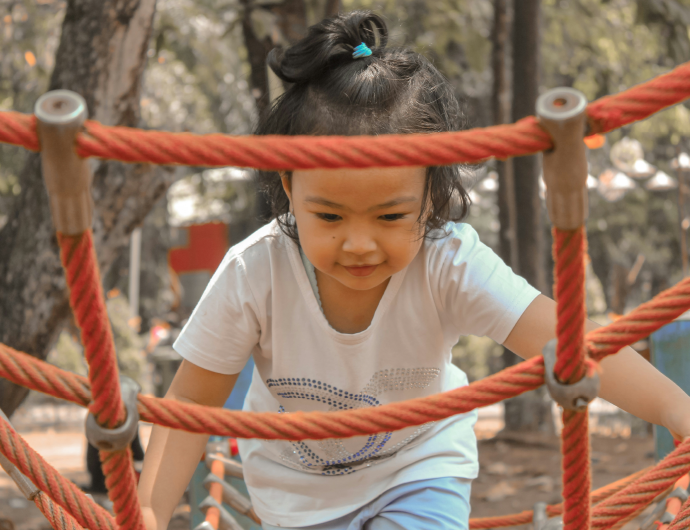
Support physical play, coordination, and the natural need for movement through engaging in physical activities. Experiencing the great outdoors through these activities can further enhance children’s connection with nature and overall well-being.
16. Animal Walks
Age: 3–5 years
Time to turn your living room or backyard into a jungle gym! Pretend play meets physical movement as kids hop like frogs, waddle like ducks, and slither like snakes.
How-To:
- Call out an animal and demonstrate how it moves (e.g., hop like a frog, waddle like a duck, slither like a snake).
- Encourage your child to imitate the animal’s movements.
- Change animals every few minutes for a fun variety of movement.
- Ask your child to come up with an animal walk and share it with you.
Learning focus: Gross motor skills, creativity, body awareness
17. Obstacle Course
Age: 3–6 years
Build a safe course using everyday items and challenge your child to conquer it! It’s a fantastic way to burn energy and build motor skills.
How-To:
- Gather household items like pillows, cones, chairs, and tunnels to create an obstacle course.
- Set up obstacles to climb over, crawl under, and weave through (make sure they’re safe).
- Challenge your child to complete the course, timing them for fun.
- For added excitement, create different challenges, such as jumping over a line or balancing on a narrow surface. Use tape lines to define the play area and enhance the challenge by marking sections to leap over.
Learning focus: Coordination, spatial awareness, problem-solving skills
18. Water Play
Age: 2–5 years
Perfect for sunny Singapore days! Water play is a sensory-rich experience that encourages exploration and joy, with a bonus splash of learning.
How-To:
- Fill a basin with water and gather cups, funnels, and water toys.
- Let your child explore the different ways they can move water around—pour, scoop, or splash.
- Create a mini water station with different-sized containers and experiment with water flow.
- For safety, supervise closely during water play, especially in outdoor settings.
Learning focus: Sensory development, fine and gross motor control
19. Balloon Volleyball
Age: 3–5 years
Too hot or rainy outside? No problem. Blow up a balloon and turn your living room into a mini volleyball court!
How-To:
- Blow up a balloon and tie a string or use a couch as the “net.”
- Take turns hitting the balloon back and forth over the line, trying not to let it touch the ground.
- To increase the challenge, introduce rules like a set number of hits or require the balloon to be passed a certain way.
- Encourage teamwork when playing with multiple children.
Learning focus: Hand-eye coordination, reaction time, teamwork
20. Nature Scavenger Hunt
Age: 3–6 years
Turn a simple walk into a curious quest. A nature scavenger hunt helps children connect with the outdoors while sharpening their observation skills.
How-To:
- Create a simple list of items to find in your garden or local park (e.g., leaf, stone, flower).
- Give your child the list and ask them to find each item.
- Use a bag or basket to collect the items, turning it into an adventure.
- Discuss the items they find, focusing on their colours, shapes, and textures. Use the natural materials collected during the hunt for creative projects like arts and crafts.
Learning focus: Observation skills, curiosity, appreciation for nature
Language and Dramatic Play
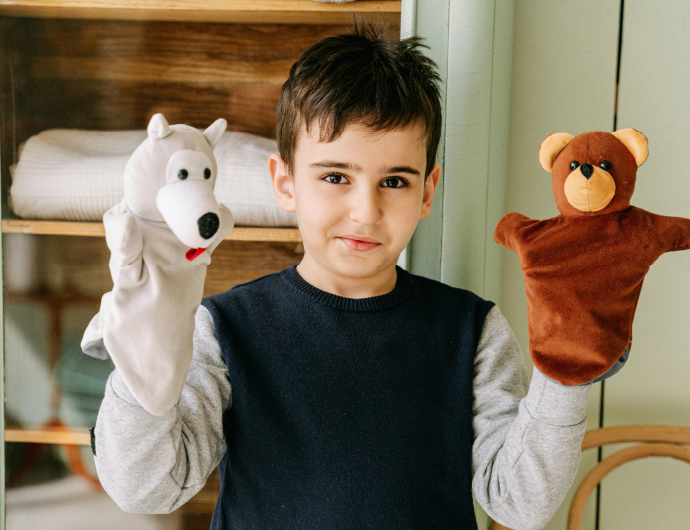
Boost communication, storytelling, and language skills through expressive and creative ideas from your child. These activities enhance vocabulary, pronunciation, comprehension, and expressive and receptive language skills. Educational activities during these sessions also promote learning and social skills among young children.
21. Puppet Shows
Age: 3–5 years
From sock puppets to finger puppets, puppet shows are a delightful way for children to express themselves while learning the art of storytelling.
How-To:
- Create simple hand or sock puppets using materials like socks, buttons, fabric, or yarn.
- Select a familiar story or invent a storyline. Tailor the show to your child’s interests to enhance engagement.
- Act out the story with the puppets, encouraging your child to voice the characters and add dialogue.
- If possible, allow your child to create puppet shows of their own and perform for family members.
Learning focus: Storytelling, expressive language, sequencing
22. Dress-Up Corner
Age: 3–6 years
Whether they’re a superhero, doctor, or chef, dress-up play lets kids experiment with roles and expand their vocabulary.
How-To:
- Set up a box or area filled with costumes, hats, scarves, and props.
- Encourage your child to choose different characters (e.g., doctor, superhero, chef).
- Ask open-ended questions like, “What’s your character doing today?” to inspire imaginative play.
- Role-play scenarios together, or let your child take the lead in their imaginative adventures.
Learning focus: Imagination, vocabulary, social interaction
23. Story Cubes
Age: 4–6 years
Roll the dice and let the pictures guide a brand-new story—every round brings a surprise!
How-To:
- Use story cubes (dice with pictures or words) or create your own using paper and drawings.
- Roll the cubes and examine the pictures/words that appear.
- Encourage your child to create a story based on what they see, helping them with sentence formation and narrative structure if needed.
- Add variations, such as using only certain cubes or making the story longer and more detailed.
Learning focus: Creativity, sentence formation, narrative flow
24. Pretend Restaurant
Age: 4–6 years
Channel your child’s love for food into imaginative play—running a restaurant is the perfect mix of fun and learning.
How-To:
- Set up a “restaurant” with fake food, menus, and notepads tailored to your child’s interests to enhance engagement.
- Role-play as customers and restaurant staff (chef, waiter, customer).
- Practice ordering food, writing down the orders, and serving food using pretend language.
- Encourage turn-taking, where your child can alternate between different roles (waiter, chef, customer).
Learning focus: Functional language, turn-taking, early writing
25. Emotion Charades
Age: 3–5 years
A fun and active way to help your child understand and express their emotions.
How-To:
- Write or draw a range of emotions (happy, sad, excited, etc.) on pieces of paper.
- Act out one emotion at a time and ask your child to guess it.
- Take turns acting out emotions, using facial expressions and body language.
- After guessing, discuss the feelings associated with each emotion, helping your child understand emotional vocabulary.
Learning focus: Emotional vocabulary, empathy, self-expression
A World of Learning Through Play
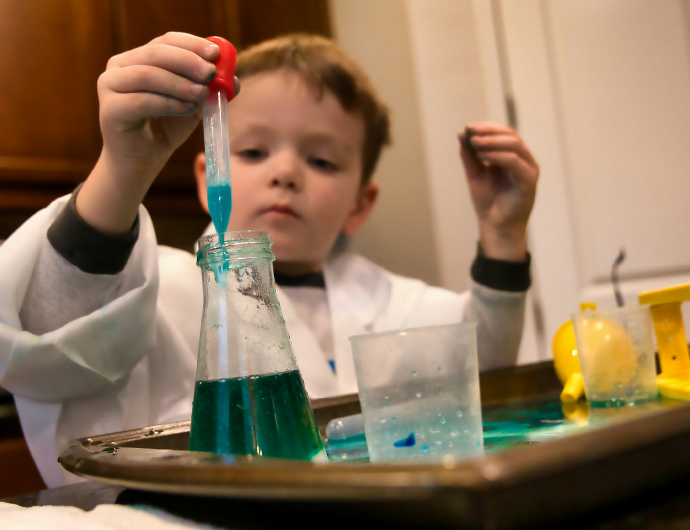
Preschoolers thrive when learning is hands-on, engaging, and rooted in play. Whether they’re experimenting with science, expressing themselves through music and art, or exploring language and numbers, each activity supports their cognitive, emotional, and social growth.
The best part? These simple, meaningful experiences don’t have to stop at home. At Little Skool House, our educators build on the very same types of play-based learning, guiding preschool children through well-rounded, research-informed activities that nurture curiosity, creativity, and confidence.
With an environment that mirrors what parents value at home, children experience a seamless and enriching transition into school life.
Want to keep the learning momentum going? Discover how Little Skool House supports your child’s development every step of the way.
